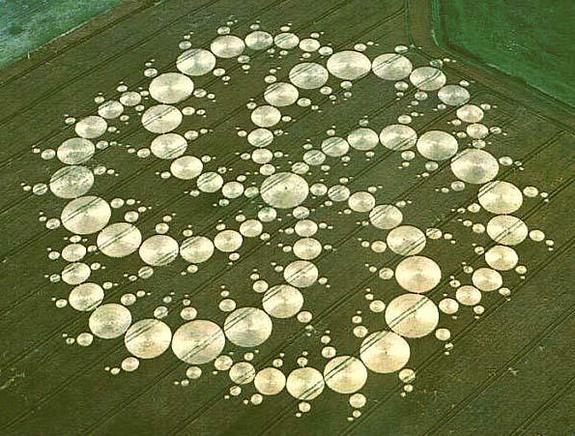Strange formations in fields of wheat and other crops have been appearing since the 1970s. Are they made by aliens parking their spaceships, or is the explanation rather more down to earth?
Of all the subjects I’ve explored for this book, the one I was most looking forward to finding more about was crop circles. For years I had been hoping there would be an extraordinary paranormal explanation for crop-circle appearances or, better still, that we were being visited by aliens from other worlds.
Then, when it became clear that most of the circles were in fact hoaxes, I relished the thought that I would finally have the chance to dismiss all the crop-circle fanatics I have heard on the radio over the years talking with great passion about the temporary parking of invisible spacecraft in a field, leaving behind an imprint in the flattened wheat when they zoom back into outer space.
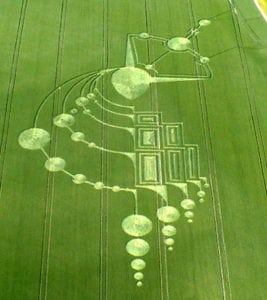 The only extra bit of evidence offered for this startling conclusion appearing to be that witnesses claim flocks of birds veer around crop-circle sites as if avoiding or circumnavigating something the rest of us cannot see.
The only extra bit of evidence offered for this startling conclusion appearing to be that witnesses claim flocks of birds veer around crop-circle sites as if avoiding or circumnavigating something the rest of us cannot see.
I was looking forward to poking fun at the gaping holes left in the arguments of these so-called experts when expounding their elaborate theories on the six o’clock news.
Indeed, I wish I had phoned in once, just once, and asked that sanctimonious old fellow on the BBC, who appeared to be contradicting himself every five minutes, a couple of simple questions: how, then, do you explain the crop circles that have appeared directly underneath power lines – how could a spaceship have landed there?
And why choose that spot when there was plenty of field in which to land without being so inconvenienced? In fact, I would pose these questions to him now if I hadn’t switched the radio off through sheer boredom, not bothering to find out his name.
At the same time I hoped that the circles weren’t all hoaxes and that I could also expose the hoaxers, who seemed to be making a real nuisance of themselves.
But having studied the evidence and looked at the extreme lengths to which the hoaxers have been prepared to go, I am no longer so sure I can.
The very first recorded example of a crop circle is a woodcut dated 1678 and entitled ‘The Mowing-Devil: or, Strange News out of Hartford-shire’ (sic), and it shows a devil cutting out a pattern in a field of wheat using a scythe.
The text explains that the greedy farmer had refused to pay a reasonable fee to the workers for the harvest that year and announced he would rather have the Devil do the work instead.
The following morning he woke to find Old Nick had done just that and the farmer became too scared to enter the field ever again and so the harvest, and his occupation, were lost.
However, crop circles didn’t come to the public’s attention until three centuries after this – in the late 1970s. Their relatively sudden appearance caused a sensation as the British press fought each other for the best photographs.
–
Keen to get ahead of the trend, several of the newspapers began employing circle makers to create ever more elaborate patterns throughout the countryside and, in the process, obviously guaranteeing themselves the first and best pictures of this mysterious new phenomenon sweeping the land.
But, while newspapers may have employed circle makers to create some of the circles they photographed, this wasn’t known about at the time and the circles appeared, for the most part, not to be manmade in origin.
During the early 1980s, crop circles began to attract serious interest with the discovery of a formation at a place called Cheesefoot Head, a high point on the chalk downlands close to Winchester. Here, a circle fifty-two feet in diameter was flanked by two others exactly half the size symmetrically placed north and south of the larger circle.
The perfect spiralling of the flattened straw and precision placement of the formation proved very difficult to explain at the time, scientifically or otherwise. Other formations soon began to appear i
n wheat, grass, rapeseed oil and many other crops.
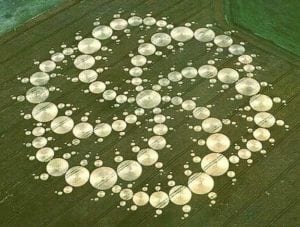
Researchers started to study the designs and began to believe that individually, or collectively, they amounted to coded messages or directions to something as yet unknown, by intelligent beings also as yet unknown.
Other physical features were pointed out, such the way a circle was aligned with the sun or moon, leading to the idea that supernatural forces were at work across the English countryside.
It seemed that such mathematically precise formations – especially the increasingly complicated circles that were emerging by the late 1980s – were not, and could never be, the work of man himself.
Then in 1991 two elderly landscape artists, Dave Chorley and Doug Bower, fired an arrow directly into the heart of the ever growing crop-circle fan club by admitting they had been making them by hand since the 1970s, after reading about the famous so-called ‘saucer nests’ (impressions left in the crops by some disc-shaped object) that had appeared in Australia.
By the time they retired from the ‘business’, Doug and Dave had successfully completed over 250 crop circles across southern England.
Crop Cirlce Artists
Doug and Dave’s inspiration, the Australian ‘saucer nests’, were a collection of seven circles in the wheat fields near Bordertown, Australia. Pre-dating these, and providing the original source of inspiration for all the modern-day crop circles that followed, was the Tully Saucer Nest, which appeared on 19 January 1966 on a piece of land at Horseshoe Lagoon near Tully, north of Queensland.
After the fruits of Doug and Dave’s labours in Hampshire and Wiltshire started to attract public attention, a veritable epidemic began to spread. Crop circles popped up everywhere. Each was immediately studied by experts, who either dismissed it as a hoax or accepted it as genuine – that is, not created by man.
Artists competed to confound these so-called experts: having one of their circles ‘proved’ genuine was the highest accolade – albeit hugely ironic that for a circle to be good enough to be considered genuine implied that no artist had been involved in its creation.
And this was a form of art, after all, even if the medium was rather avant garde: during the 1980s and 1990s, it was on a par with cutting a cow in half, preserving it in formaldehyde and displaying it at the Tate Modern. But it’s all art, isn’t it?
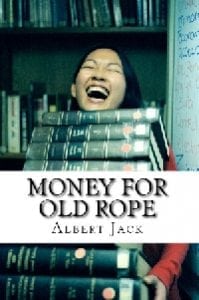
Not according to the scientists and followers of the growing crop-circle community, it wasn’t; it was deception and it continually interrupted their serious research into what appeared to be a brand-new type of paranormal activity. As their resentment grew, so the work of the circle makers became increasingly elaborate.
As soon as one design was considered too intricate for humans to create, another one would appear that was even more complicated.
And the (probably cashing-in) stories from farmers about strange lights and howling animals deepened the mystery, as did apparent reports of military helicopters hovering around circle sites.
One crop circle appeared in a field close to Stonehenge, the spiritual home of the Druids, shortly before the summer solstice in 1996. Predictably enough, the summer solstice, falling on around 21 June, is Stonehenge’s busiest day of the year and in 1996 it was even busier.
The great unwashed descended in force to appreciate the new mysterious formation and spent ages analysing each bent stem of wheat, taking electromagnetic recordings of earth samples and recording detailed cross-measurements of the circle.
The press arrived in their helicopters and photographs of the circle appeared on television and in every newspaper. When crop-circle enthusiasts began to turn up in their anorak-clad droves, the farmer erected a shed and charged an entry fee to his field, to help ‘compensate for the damage’.
By the end it is estimated he had collected over £30,000, a good day’s work when set against the £150 of damaged wheat. ‘That will be treble gin and tonics all round, please, landlord, and keep an eye out for the taxman.’
Crop circling has become big business: small companies offer gullible businessmen helicopter flights over crop circle formations. Bus tours are provided, hotels are always full in the vicinity of new designs and local tradespeople benefit from the arrival of enthusiasts. Then there are the films, books, television documentaries and radio programmes, not to mention the T-shirts and photograph collections on sale.
But there is a very good reason why those involved rarely own up to the deception and that motive is not necessarily the taxman. The main reason is that, despite open hostility between the crop-circle believers and the circle makers, usually in the direction of the circle makers, the two opposing factions are completely dependent upon each other, because, as any artist will tell you, national publicity is hard to come by.
Without the suggestion of unknown forces at work, very few people would take an interest in crop-circle art on its own merit, so artists need the mythmakers to continue to be as vocal as possible every time a circle appears.
Equally, without the circle makers, there would be no circles for otherwise bored individuals to fly over and photograph, or take to the fields en masse with their measuring tapes and electronic devices for measuring unusual electrical activity.
In the debate about whether crop circles are manmade or whether created by supernatural forces of some kind, the balance of evidence tips very much towards the the former.
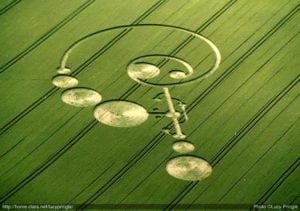 The circle makers have proved pretty conclusively that they are able to create elaborate and complicated designs using relatively simple resources – string, planks of wood, plastic piping and a garden roller – in a matter of a few hours.
The circle makers have proved pretty conclusively that they are able to create elaborate and complicated designs using relatively simple resources – string, planks of wood, plastic piping and a garden roller – in a matter of a few hours.
They have actually been filmed doing it, but the believers, while accepting that some circles are manmade, still prefer to wonder why their mobile phones fail to work in crop circles, or why flattened wheat is less electrically charged than the standing wheat nearby.
Any schoolchild with a basic understanding of physics could step forward and enlighten them by explaining that standing wheat will act like an aerial and attract the atmosphere’s electromagnetic charge better than the flattened stems.
Presumably that is why all lightning conductors point upwards from the roof of your house, and do not lie flat in the back garden. And, what’s more, my mobile phone doesn’t seem to work anywhere in the countryside, let alone in the middle of a field.
All the pseudo-science offered as solid evidence simply doesn’t stand up to detailed cross-examination. Nothing has been suggested to prove that crop circles are made by anything other than man himself.
There is absolutely no credible evidence of mysterious forces at work, and as is always the case when it comes to proving such things, we will need to see a real alternative to the ‘man in a cap with a plank of wood working at night’ principle.
Don’t expect many people to believe that ancient ruins under the ground are responsible, or mini tornadoes, plasma vortexes or any other freak of nature, because if any of these could have created the circles, then it should be easy enough for scientists to prove, or at least reconstruct under controlled conditions. But nobody ever has.
Already I can hear the believers sharpening their tongues in order to dismiss me as a CIA plant or part of a wide-ranging government cover-up programme denying the existence of extraterrestrial forces and/or denying the coded messages left in wheat fields by visitors from Mars.
That is what the crop believers usually do to vocal opponents of their mystic beliefs, and I am already looking forward to discussing it. Because there is no tangible evidence of any intergalactic interference in our wheat fields and the only slight piece of evidence ever offered always turns out to be a hoax, later admitted by the hoaxers themselves.
Usually they are the very same circle makers proving to the world how easily fooled the experts are and showing us exactly how they created them.
In one such case, from 1996, called the ‘Oliver’s Castle Video’, balls of lights, referred to by the experts as ‘BOLs’, were filmed floating across a field while a crop circle mysteriously appeared directly underneath and the cameraman was heard to whisper, ‘Wow, that’s amazing!’
Never having been in that position myself, I do not know how I might react if I saw such a thing happen right in front of me, but I imagine it is rather more likely that I would be running down the lane screaming in terror, having dropped all my equipment.
Equally suspicious is the way in which the camera stays fixed on the field where the crop circle appears, whereas most cameramen would tend to follow the balls of light with their lens, not hold the camera in one position as the BOLs floated in and out of view.
Further investigation revealed that it was indeed a hoax. John Wheyleigh, a young man from Bath, had created the illusion by filming a wheat field and using an editing programme to create the BOLs and then gradually faded out some of the wheat to leave the effect of a crop circle design. The film caused a sensation and enthusiasts all over the world tried to contact Wheyleigh, but without success.
Digging a little deeper, it came as no surprise to find that ‘Wheyleigh’ wasn’t his real name. The young man in question actually turned out to be one John Wabe, a partner in a video-editing company.
Needless to say, he sold his video, made a documentary about how he had created his film, and apparently signed a lucrative contract with a television company. Predictably, he has made himself thoroughly unpopular with the more resentment-prone members of the crop circle and UFO communities across the world, some even threatening to sue him.
Others, meanwhile, quietly ignored the hoax and carried on with their important research into intergalactic ‘messages’ left in fields of wheat.
The believers dismiss the evidence of circle makers’ as the ‘Doug and Dave effect’. Television documentaries about manmade circles are known as ‘Doug and Dave-style programmes’, and so on.
So blinkered have some of them become that any suggestion of a circle being manmade is derided. (Sceptical believers – now there’s a conundrum …) In the meantime they have given their ‘science’ a special name. Cereology, they call it and no, neither I nor the Microsoft spellchecker have ever heard of that word either.
I am already ordering my insult-proof vest in preparation for the publication of this book because I have a feeling the best reaction I can expect from the community of cereologists is to be called an idiot. We shall see. Of course, as with all of these types of mystery, it is simply impossible to prove a negative.
Some people will believe whatever they want to believe, although most of us need to see the firm evidence first, so – as with the Bigfoot mystery – please show us a carcass; some real big evidence to support your real big claims.
One company, called circlemakers and run by British artist and documentary film maker John Lundberg, makes no attempt to hide its identity, or its work. The company even accepts commercial commissions to create crop circles and has done so all over the world.
In one case it created a well-known cereal company logo and in another the Sun newspaper asked it to make a huge crop logo of the five Olympic rings to support Britain in its bid to hold the next Games. The following day they ran a front-page headline, ‘Aliens Back Our Bid’, and printed the photograph underneath.
Just stop for a minute and wonder how many people in Great Britain, or even across the world, actually believed that headline. Very few, I imagine, but I expect some dyed-in-the-wool cereologists did, even so.
When asked why he does it, John has stated that, among the numerous reasons for creating crop circles, the chief one is ‘being able to construct something that most people believe to be beyond human capability’.
Now, for me, that is a pretty good reason to do anything, and good luck to him. On their website (www.circlemakers.org) the group claim the circles they create are actually ‘genuine’ in the sense that there is no attempt on their part to deceive anybody.
They are open about their art and ridicule many of the so-called crop-circle ‘experts’ who claim to have had visits from outer space or other paranormal experiences. Well, you would too if you had spent a hard night in a wheat field constructing a giant spiral spelling out the word ‘Wheetabix’ only for somebody to claim it to be the work of little green men from Mars.
So, of the many explanations for the sudden appearance of elaborate designs found in some fields of wheat, ranging from the paranormal to the extraterrestrial, none of them have ever been supported by any genuine evidence.
And therefore none of them are as convincing as the most likely explanation – a man in a cap with some string and a plank of wood, plus a flask of tea to keep him going – which is continually dismissed by the cereologists.
So, now, I have changed my mind. I began by believing the circle makers were a bloody nuisance and wanted to find out what, if anything, had created the circles they did not. But instead the only solid evidence I can find is that people have created all of them, so now I respect their art, for art’s sake, and hope crop circles continue to appear in more and more clever and elaborate forms – and some of them are very clever indeed.
The meditation groups down in Sussex who sit in crop circles contemplating whatever it is they contemplate, can happily continue to do so as far as I’m concerned, although I think the artist should charge them a fee for it in future. Perhaps he/she could leave out a saucer for the money to be placed in. Although, on second thoughts, that might create even more confusion.
But for the many who dismiss the circle makers as publicity seekers and hoaxers, I have had another idea. Imagine H. G. Wells’s time machine, only from outside the machine rather than inside it; in other words, we just happen to be walking past the site of the inventor’s house as he flashes through our time zone on his way to the year 30,000 or whenever.
You wouldn’t see the actual time machine as it would be travelling too quickly, but its track or footprint would suddenly appear right in front of you, then gradually fade away over the next few weeks.
There you are: that’s my alternative explanation for crop circles. Scientists of the distant future have managed to build time machines and these are racing backwards and forwards through our own time zone leaving the footprint of their time machines in our fields, where they are actually standing in thousands of years’ time.
That would explain why the birds fly around them too. Now, is that any more ridiculous than any of the other theories you have heard from the real experts? And I just made that up, for fun.
But in the meantime the two opposing groups should, in my humble opinion, try to get on with each other. The artists should be allowed to continue creating their art without having their cars vandalized by the believers, and the believers should be allowed to run around in a field measuring bent wheat-straws and taking soil samples without people like me making fun of them.
And as to that, I really will try to restrain myself in future, but I can’t promise anything. – Albert Jack
Albert Jack AUDIOBOOKS available for download here
Albert Jack’s Mysterious World

